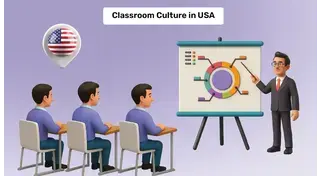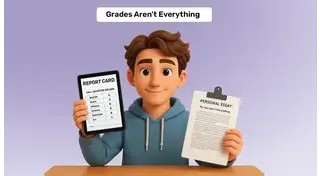A Complete Guide on How to Study Abroad
Step 1:
Exploration
Things to know before getting started: Courses, colleges, funding and more!
Step 2:
Application
Things to know for applying to study abroad: cost of study, exams, SOP and more!
Step 3:
Admission
Things to know while finalising university, networking and scholarships
Step 4:
Finance
Things to know about financing your education: loan eligibility, approval and more!
Step 5:
Visa
Things to know about pre-visa requirements, visa interview and more!
Step 6:
Prepare To Fly!
Things to know about accommodation, Forex, SIM cards, networking and more!
A quick Glimpse of your journey

Step 1:
Exploration
Things to know before getting started: Courses, colleges, funding and more!

Step 2:
Application
Things to know for applying to study abroad: cost of study, exams, SOP and more!

Step 3:
Admission
Things to know while finalising university, networking and scholarships

Step 4:
Finance
Things to know about financing your education: loan eligibility, approval and more!

Step 5:
Visa
Things to know about pre-visa requirements, visa interview and more!

Step 6:
Prepare To Fly!
Things to know about accommodation, Forex, SIM cards, networking and more!
On this Page:

Study Abroad Expert
Once you've decided to study abroad, the next step is the application process. This phase is crucial as it involves making important decisions on where and what you'll study, and how you'll apply to your chosen institutions.

Shortlist Country/Universities/Courses!
Choosing where to study is a significant decision that requires research and networking. It's about finding a place that not only offers excellent education but also suits your personal and professional growth aspirations.
 How to shortlist country or study destination?: Look at what's important to you, like culture, language, and job opportunities after you graduate. Each country has a unique vibe and different benefits, like lower tuition fees or excellent research facilities.
How to shortlist country or study destination?: Look at what's important to you, like culture, language, and job opportunities after you graduate. Each country has a unique vibe and different benefits, like lower tuition fees or excellent research facilities.
 How to shortlist universities to apply: Don't just go by rankings. Consider what matters to your study and career goals. Some universities might have strong connections to industries, offer great internships, or excel in your chosen field.
How to shortlist universities to apply: Don't just go by rankings. Consider what matters to your study and career goals. Some universities might have strong connections to industries, offer great internships, or excel in your chosen field.
 How to select the right course?: It's crucial to choose a course that lines up with what you want to do in the future. Look closely at the course content, the qualifications of the faculty, and whether it's recognized by employers in your field.
How to select the right course?: It's crucial to choose a course that lines up with what you want to do in the future. Look closely at the course content, the qualifications of the faculty, and whether it's recognized by employers in your field.
Use GyanDhan’s Profile Evaluation Tool
Networking with current students, alumni, or faculty can provide valuable insights and help in making informed decisions. For for data driven decision making try GyanDhan’s Admit Predictor tool. It’s a simple way to gauge your chances for an MS in the US, for free. Using insights from over 200,000 historical data points, it offers you precise predictions of where you stand. More than 50,000 students have already paved their path to their dream universities with our tool. Start mapping out your higher education journey today – it's quick, precise, and absolutely free.
Calculate The Cost of Studying Abroad!
Understanding the cost of studying abroad involves more than just tuition. You'll need to consider both attendance costs like tuition and fees, and living expenses such as housing, food, and transportation. It's essential to budget for both to get a full picture of what you'll spend.
Need Expert Help with Your Admission?

Take the Right Test!
For studying abroad, you might need to take several tests:
 Standardized tests: Tests like these are often required for admission to universities. They measure your academic abilities and are used in the application process. Some common tests include -
Standardized tests: Tests like these are often required for admission to universities. They measure your academic abilities and are used in the application process. Some common tests include -
 GRE: A test for students applying to graduate schools, measuring verbal reasoning, quantitative reasoning, and analytical writing skills.
GRE: A test for students applying to graduate schools, measuring verbal reasoning, quantitative reasoning, and analytical writing skills.
 GMAT: Aimed at applicants to business schools, testing verbal, mathematical, and integrated reasoning skills.
GMAT: Aimed at applicants to business schools, testing verbal, mathematical, and integrated reasoning skills.
 SAT: Primarily for college admissions in the US, it assesses reading, writing, and math skills.
SAT: Primarily for college admissions in the US, it assesses reading, writing, and math skills.
 ACT: Another test for college admissions in the US, covering English, math, reading, and science reasoning.
ACT: Another test for college admissions in the US, covering English, math, reading, and science reasoning.
 English language proficiency (ELP): If you're going to study in English, tests like the given below are the tests that assess your language skills to ensure you can succeed in your courses.
English language proficiency (ELP): If you're going to study in English, tests like the given below are the tests that assess your language skills to ensure you can succeed in your courses.
 IELTS: An English language proficiency test for study, work, and migration, assessing listening, reading, writing, and speaking skills.
IELTS: An English language proficiency test for study, work, and migration, assessing listening, reading, writing, and speaking skills.
 TOEFL: Tests English language proficiency in academic settings, covering reading, listening, speaking, and writing.
TOEFL: Tests English language proficiency in academic settings, covering reading, listening, speaking, and writing.
 PTE: Another English proficiency test focusing on academic English for studying abroad, including speaking and writing, listening, and reading.
PTE: Another English proficiency test focusing on academic English for studying abroad, including speaking and writing, listening, and reading.
 Duolingo: A newer, more flexible English language test accepted by some institutions, assessing reading, writing, speaking, and listening through a computer-based test.
Duolingo: A newer, more flexible English language test accepted by some institutions, assessing reading, writing, speaking, and listening through a computer-based test.
 Country-specific test: Some countries have specific requirements. For example, Germany might ask for TestDaF for German proficiency, while France has the TCF for French.
Country-specific test: Some countries have specific requirements. For example, Germany might ask for TestDaF for German proficiency, while France has the TCF for French.
Each test serves a unique purpose in the application process, so it's crucial to understand which ones you'll need for your target country and program.
Apply to The Shortlisted Universities!
When you're ready to apply to your shortlisted universities, it's important to craft a strong Statement of Purpose (SOP), secure compelling Letters of Recommendation (LORs), and polish your resume to showcase your qualifications.

Prepare SOP: Parts of SOP
Your SOP should reflect who you are beyond grades and scores. It usually includes your academic interests, professional goals, reasons for choosing the program, and how it fits into your career path. Including details to strengthen your SOP by demonstrating your commitment and contributions to your field. Incorporating research papers, projects, and achievements into your application can significantly strengthen it:
 Research papers: Highlighting research you've been involved in demonstrates your ability to conduct in-depth study and contributes to your field, showing universities your scholarly commitment and potential for advanced research.
Research papers: Highlighting research you've been involved in demonstrates your ability to conduct in-depth study and contributes to your field, showing universities your scholarly commitment and potential for advanced research.
 Projects: Discussing projects, especially those relevant to your intended field of study, showcases practical experience, problem-solving skills, and the ability to apply theoretical knowledge in real-world scenarios.
Projects: Discussing projects, especially those relevant to your intended field of study, showcases practical experience, problem-solving skills, and the ability to apply theoretical knowledge in real-world scenarios.
 Achievements: Outlining your academic and extracurricular achievements gives admissions committees a sense of your dedication, leadership skills, and capacity to excel both inside and outside the classroom.
Achievements: Outlining your academic and extracurricular achievements gives admissions committees a sense of your dedication, leadership skills, and capacity to excel both inside and outside the classroom.
Each element provides a fuller picture of your abilities and accomplishments, making your application more compelling.
How Should an Ideal SOP Look Like?
Creating a standout Statement of Purpose (SOP) involves sharing your unique story in a way that connects your past experiences with your future ambitions. An ideal SOP touches on factors given below:
 Introduction: Share a pivotal moment or project that directed you towards your field.
Introduction: Share a pivotal moment or project that directed you towards your field.
 Academic background: Outline your educational journey and achievements.
Academic background: Outline your educational journey and achievements.
 Research and projects: Detail the research you've conducted and projects you've completed.
Research and projects: Detail the research you've conducted and projects you've completed.
 Professional experience: Highlight relevant work experience.
Professional experience: Highlight relevant work experience.
 Future ambitions: Discuss your career goals and aspirations.
Future ambitions: Discuss your career goals and aspirations.
 Program fit: Explain why you're choosing the specific course and university.
Program fit: Explain why you're choosing the specific course and university.
 Conclusion: Tie your past experiences with how the program will help you achieve your future goals.
Conclusion: Tie your past experiences with how the program will help you achieve your future goals.
This structure ensures your SOP is engaging, comprehensive, and tailored to your application.

Get Your Letters Of Recommendation
Letters of Recommendation (LORs) offer a unique view of your skills and potential through the eyes of those who know you in a professional or academic setting. They add depth to your application by providing concrete examples of your achievements and work ethic, helping to paint a fuller picture of you as a candidate. There are 2 types of LOR’s -
 Academic LORs: typically written by professors, delve into your scholarly aptitudes, highlighting your intellectual contributions and academic prowess. They're essential for showcasing your suitability for further academic pursuits.
Academic LORs: typically written by professors, delve into your scholarly aptitudes, highlighting your intellectual contributions and academic prowess. They're essential for showcasing your suitability for further academic pursuits.
 Professional LORs: On the other hand, are penned by work supervisors or colleagues who can testify to your professional skills, work ethic, and ability to collaborate effectively within a team.
Professional LORs: On the other hand, are penned by work supervisors or colleagues who can testify to your professional skills, work ethic, and ability to collaborate effectively within a team.
These LOR’s offer a glimpse into how you apply your knowledge and skills in real-world scenarios, underscoring your readiness for the professional aspects of your chosen field.

Prepare Your Resume
Your resume is more than just a list of accomplishments; it's a reflection of your journey and capabilities. It should effectively encapsulate your educational achievements, including how you've navigated any academic setbacks, which can showcase your resilience. Additionally, it is a critical component of your application, summarizing your academic background, work experience, and other relevant details.
 College Grade (Backlogs): Clearly presenting your academic performance, including any backlogs, is crucial. Addressing backlogs transparently can also be an opportunity to highlight your resilience and ability to overcome challenges.
College Grade (Backlogs): Clearly presenting your academic performance, including any backlogs, is crucial. Addressing backlogs transparently can also be an opportunity to highlight your resilience and ability to overcome challenges.
 Work Experience: Detailing your work experience shows practical application of your skills and knowledge. It's a chance to demonstrate professional growth, leadership qualities, and contributions to your field
Work Experience: Detailing your work experience shows practical application of your skills and knowledge. It's a chance to demonstrate professional growth, leadership qualities, and contributions to your field
Crafting your resume carefully can shine a light on your achievements and readiness for new challenges ahead.

Apply For Scholarships!
Seeking scholarships to study abroad is a vital part of planning your study abroad journey. It involves finding funds that match your educational goals and completing a detailed application process.
 Selecting the right scholarship: Start with thorough research to identify scholarships for which you're eligible. Consider the scholarship's focus, whether it aligns with your academic or professional interests, the amount it offers, and the application deadline. Understanding these elements ensures you apply for scholarships that truly complement your educational aspirations.
Selecting the right scholarship: Start with thorough research to identify scholarships for which you're eligible. Consider the scholarship's focus, whether it aligns with your academic or professional interests, the amount it offers, and the application deadline. Understanding these elements ensures you apply for scholarships that truly complement your educational aspirations.
 Applying for scholarships: The application process can be extensive. It usually requires you to submit a detailed form, academic records, essays, and sometimes letters of recommendation. Each scholarship has its own requirements and values, so tailor your application to reflect how you meet these criteria. Be meticulous in following instructions and expressing how the scholarship aligns with your goals and values.
Applying for scholarships: The application process can be extensive. It usually requires you to submit a detailed form, academic records, essays, and sometimes letters of recommendation. Each scholarship has its own requirements and values, so tailor your application to reflect how you meet these criteria. Be meticulous in following instructions and expressing how the scholarship aligns with your goals and values.
Approaching scholarship applications with attention to detail and a clear understanding of each scholarship’s criteria can significantly boost your chances of success.

Finalise The Sources of Funds!
Finalizing your sources of funding for studying abroad is a strategic step in your education journey. It requires understanding when to apply for funding, considering various factors in choosing your funding source, and knowing how to distribute your efforts among these options.
 Right time to apply for funds: Start early, ideally a year before your program begins. Many scholarships and grants have deadlines well in advance of the academic year.
Right time to apply for funds: Start early, ideally a year before your program begins. Many scholarships and grants have deadlines well in advance of the academic year.
 Factors to consider while selecting the source of funds: Evaluate interest rates for loans, eligibility requirements for scholarships, and whether funding sources are renewable or one-time.
Factors to consider while selecting the source of funds: Evaluate interest rates for loans, eligibility requirements for scholarships, and whether funding sources are renewable or one-time.
 Selection/Bifurcating between various sources: Diversify your funding sources. Apply for multiple scholarships and consider a mix of grants, loans, and personal savings to cover all bases.
Selection/Bifurcating between various sources: Diversify your funding sources. Apply for multiple scholarships and consider a mix of grants, loans, and personal savings to cover all bases.
Strategically approaching each step ensures you have the necessary funds secured for your study abroad experience.
Suggested Blogs

Network with a community of curious students, just like you
Join our community to make connections, find answers and future roommates.. Join our CommunityUpcoming Events







